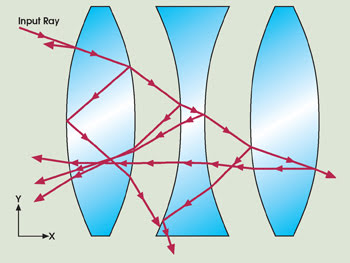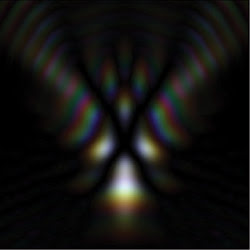Dr. Kenneth E. Moore, Zemax Development Corp.
The optical engineering discipline has entered a golden age. The computational power of personal computers has steadily increased for 20 years while costs have fallen. Similarly, the technical capability of optical design software has increased dramatically, and easy-to-use, state-of-the-art programs are available at much lower cost than in years past.
The market for optical system design software traditionally has been divided into two categories: sequential lens design for imaging systems and nonsequential for nonimaging systems. Sequential lens design is based on surfaces, which define the boundary between two types of media, such as air and glass. Sequen-tial programs generally support optimization, tolerancing and detailed analysis of the performance of imaging systems. For nonsequential optical design, the most powerful programs available today are based on solids rather than surfaces. Few commercial software offerings include both capabilities.
The optical industries that are experiencing growth use both sequential and nonsequential optical modeling. Among these industries are remote sensing, aerospace and defense, space and astronomical optics, optical communications, information display, medical, automotive and architectural, and companies that use low-cost imaging systems for consumer products.

Figure 1. A combined sequential and nonsequential analysis permits tracing of stray, scattered and ghost rays in an imaging system.
By combining sequential and nonsequential ray trace capability, the user can do types of analysis that were not possible in the past. For example, a designer can optimize, analyze and tolerance an imaging system within the sequential features of Zemax, and then convert the lens for nonsequential analysis for detailed modeling of lens scattering, stray light, veiling glare or pupil ghosts. All of the data stays within one program, so iterative design can occur with no concerns about data accuracy.
This dual capability enhances productivity and allows more accurate and rapid optical design, and it can support mixing sequential and nonsequential optics within a system. For example, the user could place a complex faceted lens object or lens arrays within an otherwise sequential imaging system.
No program can include all of the possible surfaces, solids, materials and analysis options that every user will ever need. Therefore, one of the most important capabilities of a program is user-extendable features.
In recent years, data compatibility between programs has become crucial to efficient and accurate engineering. One way to transfer data between programs is to use an intermediate common file format, such as one based on the computer-aided drafting (CAD) tool kits.
One of the key difficulties in maintaining compatibility between optical and mechanical design programs is data accuracy. Optical design programs are structured to maintain extremely high precision representations of the positions and shapes of optical components.

Figure 2. This true-color diffraction point spread function shows color fringing effects for a white-light lens with a coma defect on one surface.
This problem becomes most noticeable when exporting descriptions of arbitrary high-order aspheres from an optical design program to a CAD program using a CAD format file. Most CAD programs use splines or nonuniform rational B-spline-type surfaces, which represent the surface as a series of piece-wise low-order splines. Low-order splines, no matter how many are used, are simply not the same shape as a higher-order polynomial at optically important dimensions.
Although modern programs are capable of detailed calculations and accurate modeling, applying computer power and software technology to a given optical design program still requires a skilled optical designer. The single greatest challenge facing the optical design software industry today is the education and support of the software end user. University-level courses in optical design will continue to integrate software modeling skills into the curriculum. The Internet will undoubtedly play a role in providing guidance and assistance to users.
Ultimately, no amount of software development will ever be a substitute for a user’s design and software experience or for competent technical support.
Meet the author
Kenneth E. Moore is president of Zemax Development Corp. in San Diego and the developer of the Zemax program. He holds a PhD in optical sciences from the University of Arizona.